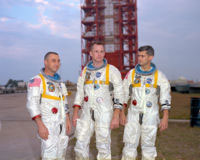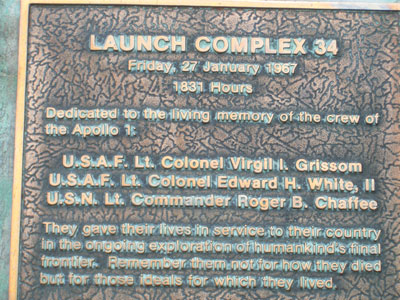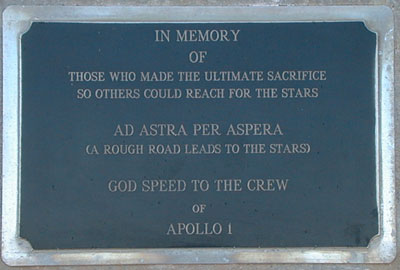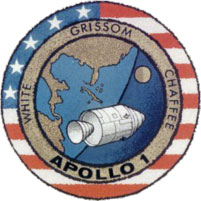From the earth to the moon《从地球到月球》精讲之二
Download
影片对白

Gus Garrison: Okay. This is the command pilot. One, two, three, four, five.
Mission operation: Ok. You're garbled, but I think maybe we can get through like this. Senior Pilot, one more time, please.
Ed White: Roger. Senior pilot's transmitting. One, two, three, four. I have senior pilot.
Mission operation: We're not copying anybody five by. We've tried about every mode. We never did hear the pilot.
Roger Chaffee: Pilot hasn't talked yet. How's this? One, two, three, four, five.
Mission operation: Okay, Roger. You're all comin' in about the same. You have to bear with us, because sometimes we don't get your transmissions.
Roger Chaffee: Okay, SDC.
Mission operation: If you run into many more communications problems-- We're down. Copy?
Mission operation: Steve, I need you at the phone.
Mission operation: I didn't read you, Chuck, at all. I can't read you, Chuck. Wanna try the phone?
Gus Garrison: How are we gonna get to the moon if we can't talk between three buildings?
Mission operation: Didn't read you. Can you repeat?
Gus Garrison: I can't hear a thing they're saying. Jesus Christ. I said, how are we gonna get to the moon if we can't talk between two or three buildings?
Mission operation: Okay, that's a little better, Chuck.
Mission operation: Give us a count on black-three. We'll try to figure out why you're coming in on black-two.
Gus Garrison: Okay. You want us to sit by here till we get this stuff squared away?
Mission operation: Uh, Chuck, I didn't read--
Mission operation: Test countdown hold continues at T minus ten.
Mission operation: Apollo 1, how do you read? Apollo 1, how do you read? Apollo 1, how do you read?
Gus Garrison: I read you fine. The problem is you're not reading me.
Deke Slayton: We're gonna get a new backup system. I sent a guy out for a couple of empty soup cans and some string. A lot of string.
Ed White: Really getting ridiculous.
Mission operation: Sounds like we got an open mike somewhere.
Deke Slayton: We better find it.
Rogar Chaffee: Fire! We got a fire in the cockpit!
Mission operation: Did he say "fire"?
Mission operation: On the monitor!
Rogar Chaffee: We got a bad fire!
Man: We keeping you from something, Stormy?
Harrison Storms: Rick's rehearsal dinner. I promised Phyllis I wouldn't be late.
Man: Sure she's never heard that before.
Secretary: Control is on the line from the Cape. There's a fire in the spacecraft.
Secretary: Mr. Shea, I was just trying the house. I thought you were going straight home from the airport.
Joe Shea: I have a couple of things I still need to take a look at.
Secretary: Mission Control just called.There's some situation with the test. They wanted you to come over right away.
Joe Shea: What kind of situation?
妙语佳句,活学活用
1. Command pilot 飞行指挥
2. Senior Pilot noun 高级飞行员 (通常是实际执行飞行任务的飞行员)
3. We're not copying anybody five by.
Copy 在这里的意思是“to receive and understand (a radio message or its sender). 充分了解,接收,收到(例如无线电讯息)”,我们来看个例子:I copy you loud and clear. 下文中的read也是表示“接收,收到(无线电讯息)”的意思。
Five by 这里指的是无线电信号接收的频率。In voice procedure (the techniques used to facilitate spoken communication over two-way radios) a station may request a report on the quality and strength of signal they are broadcasting. In the military of the NATO countries, and other organizations, the signal quality is reported on two scales; the first is for signal strength, and the second for signal clarity. Both these scales range from one to five, where one is the worst and five is the best. The listening station reports these numbers separated with the word "by". 这里引出一个片语Five by five,it means a signal that has excellent strength and perfect clarity — the most understandable signal possible.
推而广之,Five by five 可以表示 "I understand you perfectly"。
4. Square away
这个片语的意思是“Put in order; get ready for 整理,准备好”,例如:
Once we've got the files squared away, we can decide on next year's repertory.
She had to square away the house before leaving town.
5. Open mike
这里是指“开着的麦克风”,例如:Do not rustle papers, pour out glasses of water, drum your fingers on the work surface, etc., in front of an open mike. Avoid noisy bangles in the booth.
6. On the line
这里是指“on the phone”,“在打/接电话”。
7. There's some situation with the test.
Situation 本意指“形式,情况,事态(通常指不好的)”,这句话的意思是:“测试出了点情况”。 我们也可以用这句话来表示任何事物出了情况:There’s some situation with the contest.
文化面面观
Apollo 1 阿波罗一号灾难纪实
继苏联之后,美国也实现载人飞船在外太空飞行。之后,为了能在太空计划上胜过苏联,美国加紧了登月的步伐。阿波罗一号是登月计划中第一艘飞船的代号。
Apollo 1 is the official name given to the Apollo/Saturn 204 (AS-204) spacecraft, destroyed by fire during a training exercise on January 27 1967, at Pad 34 (Launch Complex 34 at Cape Canaveral - then known as Cape Kennedy) atop a Saturn IB rocket. Its crew were the astronauts selected for the initial Apollo program mission and all three died in the accident: Command Pilot Virgil I. "Gus" Grissom, Senior Pilot Ed White, and Pilot Roger B. Chaffee.
Crew
 Apollo 1 crew portrait
Apollo 1 crew portrait
(L-R: Grissom, White and Chaffee)
Virgil Grissom (flew on Mercury-Redstone 4 & Gemini 3), Command Pilot
Ed White (flew on Gemini 4), Senior Pilot
Roger B. Chaffee (never flew in space), Pilot
The accident
The "plugs-out" test planned for January 27, 1967, was never actually carried out, as the fire took place before connections to the Apollo-Saturn were withdrawn.
The Apollo 1 Command Module was a "Block I" design, built for spaceflight but never intended for a trip to the moon, as it lacked the necessary docking equipment.
Immediately prior to the accident, the crew members were reclining in their horizontal couches, running through a checklist of things they would do in space while a communication system problem was being fixed. At 6:31 (23:31 GMT) a voice (now believed to be Chaffee's, as his was the only clear channel) was heard over the COM link, "We've got fire in the cockpit." A few seconds later, the transmissions ended with a cry of pain. On the television monitors, Ed White was seen attempting to open the hatch.
The fire
 Apollo 1 plaque that is attached to Launch Complex 34
Apollo 1 plaque that is attached to Launch Complex 34
The fire spread quickly and, within seconds, was out of control. As a result of toxic smoke and malfunctioning gas masks, ground crew needed five minutes to open the hatch and suppress the flames. The fire had melted the astronauts' nylon space suits and the air lines which connected them to the capsule's life support systems. Grissom's and White's suits were found to have fused together. It was evident from how the bodies lay that they had tried to get out, but they never had a chance. Ed White, who was supposed to open the hatch, was partway out of his harness and had apparently made an effort to escape. The procedure would have had Grissom lower White's headrest, and White proceed to unlatch over 12 bolts to release the hatch. Indeed, even if he were to accomplish that feat, the internal pressure had risen so high that the inward-opening hatch could not have been opened. Chaffee's job was to begin shutting down the spacecraft and maintain communications with ground control. He was found dead still strapped into his right hand seat. Only 17 seconds from the first call of "Fire!", all three were dead.
According to the Report of the Apollo 204 Review Board — Appendix D Panel 11, Grissom suffered third degree burns on 36% of his body (1st, 2nd and 3rd degree burns covered 60% of his body) and his spacesuit was 70% destroyed. White suffered third degree burns on 40% of his body (1st, 2nd and 3rd degree burns covered 48% of his body) and his spacesuit was 25% destroyed. Chaffee suffered third degree burns on 23% of his body (1st, 2nd and 3rd degree burns covered 29% of his body) and his spacesuit was 15% destroyed. However, it was later confirmed that the crew had actually died of smoke inhalation rather than burns.
 Second Apollo 1 plaque that is attached to Launch Complex 34
Second Apollo 1 plaque that is attached to Launch Complex 34
The company that produced the command module, North American Aviation, had originally suggested that the hatch open outward and be able to open with explosive bolts in case of emergency. They had also suggested that the atmosphere be an oxygen/nitrogen mixture, like on the earth's surface. NASA didn't agree, arguing that the hatch could be accidentally opened (this is what caused Liberty Bell 7 — ironically, piloted by Grissom — to sink into the ocean during splashdown recovery operations; Grissom himself argued that the hatch should be stronger, more secure, and harder to open), and that if too much nitrogen were released into the atmosphere, the astronauts would pass out and then die. They also argued that since a pure oxygen atmosphere was used safely in Mercury and Gemini, it should be safe to use for Apollo. Furthermore, such a design saved weight.
Cause
The fire is believed to have been caused by a spark somewhere in the capsule's 50 km (31 miles) of wiring. Due to the pure oxygen inside the capsule (which was at a pressure of 15 psi or 100 kPa), the fire was quickly out of control. The Apollo 204 Review Board determined that a silver-plated copper wire running through an environmental control unit near the command module pilot's couch had become stripped of its teflon insulation and abraded by repeated opening and closing of an associated access door. This weak point in the wiring also happened to pass near a junction in an ethylene glycol/water cooling line, which had developed a leak. The electrolysis of ethylene glycol solution with the anode made of silver resulted in a violent exothermic reaction that ignited the ethylene glycol mixture, which in turn was able to burn in the atmosphere of pure pressurized oxygen. A similar March 1961 incident had previously claimed the life of Soviet cosmonaut trainee Valentin Bondarenko when a fire started in the pure oxygen atmosphere in the isolation chamber he had been occupying, a calamity the USSR had, for years, concealed from the public. The NASA investigation found that a bar of aluminum can burn like wood in a pure oxygen atmosphere. It also found substandard wiring in the craft and a missing socket wrench that was ruled out as the fire's cause. Many items on board were flammable, and flammable Velcro had been applied to the walls of the craft to secure items in weightless conditions.
Memorial
 Mission insignia
Mission insignia
While Launch Complex 34 has been essentially dismantled, the concrete and steel-reinforced launch platform remains at the site. The launch platform is located at 28.52182° N 80.561258° W. The platform bears two plaques for the 3 men who died.
Three stars, Navi, Dnoces and Regor were named in honor of the crew. The names are "Ivan", "Second" and "Roger" spelled backwards. Ivan was Grissom's middle name and White was Edward H. White the Second. The crew used the stars to calibrate their equipment and, as a practical joke, recorded the names in official NASA documentation. The names eventually stuck as a posthumous honor.
In addition, craters on the Moon and hills on Mars are named after the three astronauts.
Three public schools in Huntsville, Alabama, home of George C. Marshall Space Flight Center and the United States Space and Rocket Center, are named for the Apollo 1 crew. They are Virgil Grissom High School, Ed White Middle School, and Roger Chaffee Elementary School.
Gus Grissom and Roger Chaffee were both buried at Arlington National Cemetery. Ed White was buried at the cemetery at the United States Military Academy in West Point, New York. Their names are also enshrined together on the Astronaut Memorial at the Kennedy Space Center Visitor Complex in Merritt Island, Florida.
考考你
用今日所学将下面的句子译成英语。
1. 离开之前你得把房间收拾好。
2. 你在给谁打电话?
3. 我非常明白你话的意思。
From the earth to the moon《从地球到月球》精讲之一 考考你 参考答案
1. 简向宴会组织者要了一份和摩根夫妇的婚礼宴会差不多的菜谱。
Jane asked the caterer for a menu along the lines of the Morgans' wedding reception.
2. 我不确定。应该在1933到1936年之间吧。
I’m not sure. Somewhere between 1933 and 1936.
3. 不久的将来我们就会有辆车了。
We’ll have a car in the immediate future.